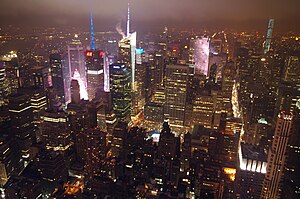
The building form most closely associated with New York City is the skyscraper, which has shifted many commercial and residential districts from low-rise to high-rise. Surrounded mostly by water, the city has amassed one of the largest and most varied collection of skyscrapers in the world.[1]
New York has architecturally significant buildings in a wide range of styles spanning distinct historical and cultural periods. These include the Woolworth Building (1913), an early Gothic revival skyscraper with large-scale gothic architectural detail. The 1916 Zoning Resolution required setback in new buildings, and restricted towers to a percentage of the lot size, to allow sunlight to reach the streets below.[2] The Art Deco design of the Chrysler Building (1930) and Empire State Building (1931), with their tapered tops and steel spires, reflected the zoning requirements. The Chrysler Building is considered by many historians and architects to be one of New York's finest, with its distinctive ornamentation such as V-shaped lighting inserts capped by a steel spire at the tower's crown.[3] Early influential examples of the International Style in the United States are 330 West 42nd Street (1931) and the Seagram Building (1958). The Condé Nast Building (2000) is an important example of green design in American skyscrapers.[4]
The character of New York's large residential districts is often defined by the elegant brownstone rowhouses, townhouses, and tenements that were built during a period of rapid expansion from 1870 to 1930.[5] In contrast, New York City also has neighborhoods that are less densely populated and feature free-standing dwellings. In the outer boroughs, large single-family homes are common in various architectural styles such as Tudor Revival and Victorian.[6][7][8] Split two-family homes are also widely available across the outer boroughs, for example in the Flushing area.
Stone and brick became the city's building materials of choice after the construction of wood-frame houses was limited in the aftermath of the Great Fire of 1835.[9][10] Unlike Paris, which for centuries was built from its own limestone bedrock, New York has always drawn its building stone from a far-flung network of quarries and its stone buildings have a variety of textures and hues.[11][12] A distinctive feature of many of the city's buildings is the presence of wooden roof-mounted water towers. In the 19th century, the city required their installation on buildings higher than six stories to prevent the need for excessively high water pressures at lower elevations, which could burst municipal water pipes.[13] Garden apartments became popular during the 1920s in outlying areas, including Jackson Heights in Queens, which became more accessible with expansion of the subway.[14]
- ^ "About New York City". Emporis. Archived from the original on March 9, 2007. Retrieved March 21, 2007.
{{cite web}}: CS1 maint: unfit URL (link) - ^ Fischler, Raphael (1998). "The Metropolitan Dimension of Early Zoning: Revisiting the 1916 New York City Ordinance". Journal of the American Planning Association. 64 (2): 170–188. doi:10.1080/01944369808975974.
- ^ "Favorites! 100 Experts Pick Their top 10 New York Towers". The Skyscraper Museum. January 22, 2006. Retrieved April 11, 2007.
- ^ Pogrebin, Robin (April 16, 2006). "7 World Trade Center and Hearst Building: New York's Test Cases for Environmentally Aware Office Towers". The New York Times. Retrieved July 19, 2006.
- ^ Plunz, Richar A. (1990). "Chapters 3 [Rich and Poor] & 4 [Beyond the Tenement]". History of Housing in New York City: Dwelling Type and Change in the American Metropolis. Columbia University Press. ISBN 0-231-06297-4.
- ^ Garb, Margaret (March 1, 1998). "If You're Thinking of Living In/Riverdale, the Bronx; A Community Jealous of Its Open Space". The New York Times. Retrieved February 5, 2024.
- ^ "New York Metro: 6 Affordable Neighborhoods". nymag.com. September 17, 2001. Archived from the original on June 30, 2018.
- ^ Shaman, Diana (February 8, 2004). "If You're Thinking of Living In/Douglaston, Queens; Timeless City Area, With a Country Feel". The New York Times. Retrieved February 5, 2024.
- ^ Lankevich (1998), pp. 82–83.
- ^ Wilson, Rufus Rockwell (1902). New York: Old & New: Its Story, Streets, and Landmarks. J. B. Lippincott. p. 354.
- ^ B. Diamonstein–Spielvoegel, Barbaralee (2005). The Landmarks of New York. Monacelli Press. ISBN 1-58093-154-5.
- ^ Whyte, William H. (1939). The WPA Guide to New York City. New Press. ISBN 1-56584-321-5.
- ^ Elliot, Debbie (December 2, 2006). "Wondering About Water Towers". National Public Radio. Archived from the original on May 3, 2007. Retrieved April 11, 2007.
- ^ Hood, Clifton (2004). 722 Miles: The Building of the Subways and How They Transformed New York. Johns Hopkins University Press. pp. 175–177. ISBN 0-8018-5244-7.